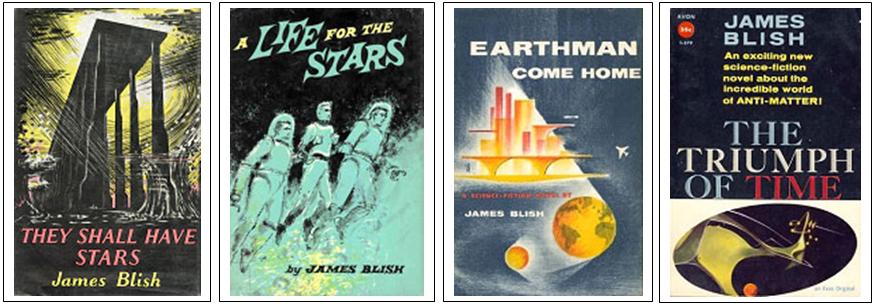No. 19 – 2013 June – James Benjamin Blish, Cities in Flight, and Technical Exposition.

James Benjamin Blish may not be as widely known as he ought to be, not when you consider the number of Star Trek novelizations he produced. There are a few of Star Trek’s TOS episodes he didn’t adapt into novels: The Children Shall Lead, Shore Leave, Mudd’s Women, I Mudd. He was working on them, but died before he got around to them. His wife Judith Anne Lawrence managed to finish the adaptation of the last two, published as: Mudd’s Angels (1978). The novel, Spock Must Die! is an original work of his.

He was born, 23-May-1921, in East Orange, New Jersey; one of those sprawling urban burgs surrounded by numerous small parks, but only minutes from downtown Manhattan. By ten, he had a subscription with Amazing Stories. By eleven, Astounding published one of his letters because he was so enthusiastic about science fiction.
Blish graduated with a zoology degree, was drafted into the Army as a medical technician, and after the war switched from studying zoology to literature. Although he didn’t get his M.A., he rewrote his thesis on Ezra Pound and sold to The Sewanee Review.
He did freelance writing, not writing exclusively science fiction [Western Action, Crack Detective Stories, & Super Sports], worked for trade magazines [Frosted Food Trade & Drug Trade News], was a reader for a literary agency, and also worked as editor for magazines, even writing teleplays for Captain Video.

Blish coined the phrase ‘gas giant’ and is credited with several fictional technology concepts. The Dirac Radio permits faster-than-light communications; the Haertel Drive is a supra-luminal drive, and the Spindizzy is an artificial gravity device. Additionally, ascomycin, an anti-aging drug, makes humans nearly immortal, and that provides a mechanism for long, interstellar voyages. Pantropy is a genetic engineering discipline that modifies humans for new planetary environments–instead of terraforming the planets.
These concepts provide a full range of adaptive technical possibilities, a cadre of critical elements needed for an expanding civilization. These ideas commingle in numerous works, creating a loose collective often thought of as the Haertel Scholium, a series of works that employ these inventions in various capacities.
For instance, the Dirac Radio is a unifying force for galactic civilization, but in one work it’s discovered by Captain Robert Weinbaum, the head of the Department of Intelligence, that all the transmissions coexist with all other transmissions in all of time and space. This provides numerous opportunities for plot complications.
Unfortunately, readers may discover that whatever overall schema exists between novels, Blish sometimes constructed it as an afterthought. The patchwork sometimes shows. Don’t let the erratic elements between novels of the Heartel Scholium ruin your fun, though. Yes, you might notice discrepancies. Publishing is a fluid and dynamic environment. Perfect plot alignment betwixt plots is an ideal and we sometime catch an author off their game.
His series, Cities in Flight [They Shall Have Stars (1956), A Life For The Stars (1962), Earthman, Come Home (1955), and The Triumph of Time (1958)] employ the Spindizzy to transport entire cities through the void.
In They Shall Have Stars, [published in Analog Science Fact Science Fiction, September, 1962] the protagonist, Alaskan Senator Bliss Wagoner makes interstellar technology available to all, allowing humankind to escape Earth. Significantly, Blish uses detailed exposition in describing the engineering principles employed in the anti-gravity drive. And also worth mentioning is the anti-McCarthyism tone of the work, which describes the Western model of democracy as increasingly intolerant.
In A Life For the Stars, the Spindizzy is engaged in moving a city, Scranton, Pennsylvania, though space to the source of ore where the workers are needed. These mobile cities reject Earth as having jurisdiction over them. After a series of adventures, the protagonist, Chris, decides to become a resident of New York City, another flying city.

In Earthman, Come Home, New York City must contend with the economic collapse of a ‘jungle’ of flying cities. In preventing a Vegan orbital fort from wreaking revenge upon Earth, the mayor, John Amalfi, organizes measures to prevent this, including outfitting a small planet with a Spindizzy. New York City is installed on this planet and eventually leaves the Milky Way Galaxy for the Greater Magellanic Cloud … and more adventures.
With The Triumph of Time, Amalfi encounters aliens who are investigating a phenomenon–and its consequences. This investigation reveals that the underlying structure of the universe lies in its Big Bang/Big Crunch cycle of destructive birth and death. (Algernon Charles Swinburne wrote a poem by the same name, published in 1866. Blish, as far as I know, doesn’t make any allusion to it.)
Another series (an After Such Knowledge trilogy) begins with A Case of Conscience, followed by Doctor Mirabilis, and ends with Black Easter; something Blish only realized after he finished the last book, Black Easter.
The protagonist in A Case of Conscience is a Jesuit, part of a four-person science team, investigating an alien race: the Lithians. Without religion, the reptilian aliens live in a near utopia, a paradise without crime, conflict, or want; they possess an innate ethos. This state of affairs conflicts with the Jesuit’s own understanding of Catholic teachings.
Despite the Lithian ethos, the team’s verdict hinges on the Lithian godless state. Should they be exploited? The Jesuit is convinced Lithians are the work of Satan, despite his admiration, and votes for quarantine. On the Jesuit’s departure, a Lithian gives the Jesuit an egg; his own child to be raised on Earth. In the ethical conflicts that follow, it becomes unclear if religion or science is to blame for the tragedy to come.

One reader responded to this work by mailing Blish a copy of the Catholic Church’s guidelines on extraterrestrials; a strategy of determining if these beings have souls and whether they exist in a state of grace.

In Black Easter, Dr. Baines, an arms manufacturer, contacts Theron Ware, a black magician, to have two people killed: a competing physicist and the governor of the state. But his real goal, soon revealed, is to unleash all the demons from hell…just to see what happens. The novel ends with a declaration by Baphomet that the demons cannot be sent back to hell and that God is dead. There is, despite the trilogy billing, a follow up on this work: The Day After Judgment. It is often conjoined with Black Easter, making them a single work.
The Pantropy series springs from The Seedling Stars; a collection of short stories about adapting humans to planetary conditions instead of the far more expensive effort of terraforming a planet.

Seeding Program: an agent modified for life on Ganymede is sent to stop a scientist’s effort at seeding planets with similarly modified humans. But the agent realizes he’s been duped by his bosses, switches sides, and helps to seed the stars with modified humans.
The Thing in the Attic: monkey-like humans living in trees are banished to the forest floor for spreading heresy about the godly-giants from their past. Adapting to life on the ground, they discover the godly giants are real…and learn what future the giants had planned for them.
Surface Tension: humans crash land on Hydrot, then make themselves uniquely modified (as protozoans) in order to survive. As generations go by, these beings eventually become the dominant species on planet and build a new space ship to explore other worlds. The ship is wooden, two inches long, it breaks the surface tension of a puddle so they can explore another puddle.
Watershed: Racial tensions mounted between normals and modified humans en route to seed a backwater planet: Old Earth.
Blish is part of the Golden Age and he joined John W. Campbell’s efforts in writing the “future history” series. Blish, on occasion, would write extensively on the how–to of his technologies in his works, explaining how they worked.
Technical exposition has become an essential ingredient in writing science fiction stories. Fan interest in technical details has fanned enthusiasm for the genre and shows no sign of diminishing, despite the snickering, in some quarters, about nerds who should “get a life.”
Interest in how the Dirac Radio, the Spindizzy, the Haertel Drive, and Blish’s other technical concepts, are the bread and butter of the genre. It’s the engine that drives fan loyalty and science fiction stories to new heights.
With over four hundred works to his credit, I’ve only scratched the surface of his accomplishments. Blish has two Hugo Awards, three Retro-Hugo Awards, three Nebula Awards, and in 2002, was inducted into the Science Fiction and Fantasy Hall of Fame.
At age fifty-four, he succumbed to cancer while living in England with his second wife Judith Anne Lawrence. It seems like an awfully young age, but one can at least acknowledge it was a productive one. His is an ongoing legacy of works and we can only speculate on the potential of his “Future History.”











